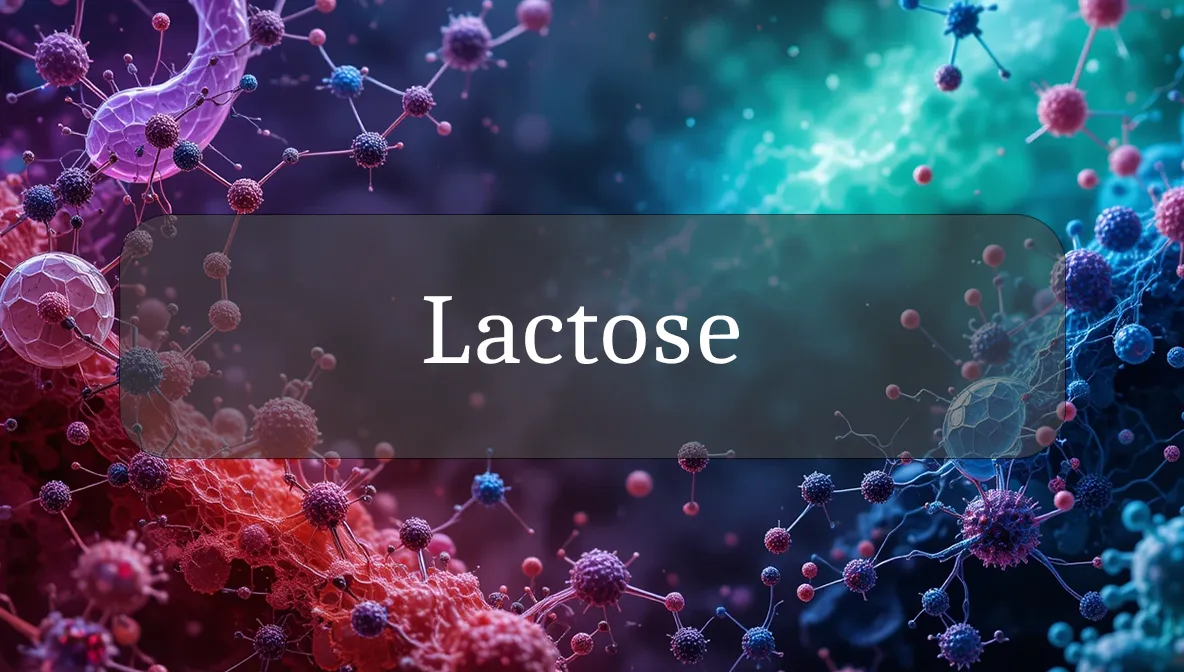Milk Sugar That Powers Energy and Gut Health
Lactose is a natural sugar found in milk and dairy products, serving as an energy source and supporting gut health when properly digested. This guide explains what lactose is, its role in your body, and practical ways to manage it for optimal wellness, especially if you struggle with lactose intolerance.
Chemical Identity and Type
Lactose is a disaccharide molecule, made up of two simple sugars: glucose and galactose, linked by a chemical bond. It’s a carbohydrate naturally found in the milk of mammals, including humans, cows, and goats. Your body uses an enzyme called lactase, produced in the small intestine, to break lactose into glucose and galactose for energy and other functions. Think of lactose as a sweet energy packet that needs unlocking by lactase to fuel your body.
Biological Role and Benefits
Lactose plays several key roles in health when properly digested:
- Energy Source: Once broken down into glucose and galactose, lactose provides quick energy for cells, especially in infants who rely on milk as their primary food.
- Gut Health: In those who digest it well, lactose supports beneficial gut bacteria (like Lactobacillus and Bifidobacterium), which produce short-chain fatty acids to nourish your gut lining.
- Bone Health: Found in dairy, lactose comes with calcium, vitamin D, and protein, which support strong bones and teeth.
- Brain Development: Galactose from lactose is a building block for brain and nerve tissues, especially important in early childhood.
When digested properly, lactose is a nutrient-rich component of a balanced diet.
Dietary or Natural Sources
Lactose is naturally found in milk and dairy products, with levels varying by source:
- High-Lactose Foods:
- Milk (cow, goat, human): ~4.5–5% lactose (about 12g per cup of cow’s milk).
- Soft cheeses (e.g., ricotta, cottage cheese): Moderate lactose content.
- Ice cream and yogurt: Varies, but yogurt may be easier to digest due to live cultures.
- Low-Lactose or Lactose-Free Foods:
- Hard cheeses (e.g., cheddar, parmesan): Trace amounts due to aging.
- Butter and ghee: Minimal lactose.
- Lactose-free milk: Treated with lactase enzyme to break down lactose.
- Plant-based milks (e.g., almond, oat): Naturally lactose-free but may lack dairy’s nutrients.
- Hidden Sources:
- Processed foods like breads, cereals, or medications may contain lactose as a filler—check labels if intolerant.
Choose dairy sources based on your ability to digest lactose or opt for lactose-free alternatives.
Signs of Imbalance or Dysfunction
Lactose intolerance, caused by low lactase enzyme levels, is the main issue related to lactose:
- Lactose Intolerance Symptoms (30–120 minutes after consuming dairy):
- Bloating, gas, or abdominal cramps.
- Diarrhea or loose stools.
- Nausea or, rarely, vomiting.
- Causes of Intolerance:
- Primary: Genetic decline in lactase production after childhood (common in East Asian, African, and Native American populations; affects ~65% of adults globally).
- Secondary: Temporary lactase deficiency from gut issues (e.g., celiac disease, infections).
- Congenital: Rare, lifelong inability to produce lactase from birth.
- Excess Concerns: Overconsuming lactose is unlikely to cause issues unless you’re intolerant, as excess is fermented by gut bacteria, leading to discomfort.
If you suspect lactose intolerance, consult a healthcare provider. Tests like a hydrogen breath test or lactose tolerance test can confirm it.
Supporting Optimal Levels or Function
To enjoy lactose’s benefits while minimizing discomfort:
- Test Your Tolerance: Start with small amounts of dairy (e.g., ½ cup milk) to gauge your body’s response. Many can tolerate 12g of lactose (1 cup milk) without issues.
- Choose Low-Lactose Dairy: Opt for hard cheeses, butter, or yogurt with live cultures, which contain less lactose or bacteria that aid digestion.
- Use Lactase Supplements: Over-the-counter lactase enzyme pills (e.g., Lactaid) can be taken with dairy to break down lactose, reducing symptoms.
- Pair Dairy Wisely: Consume milk with meals to slow digestion, improving lactose absorption. Avoid drinking milk on an empty stomach.
- Try Lactose-Free Alternatives: Lactose-free milk or fortified plant milks provide similar nutrients without discomfort.
- Support Gut Health: Eat fiber-rich foods (25–35g daily) and fermented foods (e.g., kefir) to boost beneficial gut bacteria, which may ease lactose digestion.
- Monitor Hidden Sources: If intolerant, check labels on processed foods or medications for lactose.
These strategies help you enjoy dairy’s benefits while managing lactose intolerance.
Safety, Interactions, and Precautions
Lactose is safe for most people who digest it well, but precautions are needed for intolerance:
- Safety: Lactose intolerance is uncomfortable but not dangerous. Severe symptoms may indicate another condition (e.g., IBS or celiac disease).
- Interactions:
- Dairy may reduce absorption of certain antibiotics (e.g., tetracycline). Take medications 2–3 hours apart from dairy.
- High-lactose diets in intolerant individuals can worsen gut inflammation or diarrhea, especially during gut infections.
- Precautions:
- If you’re lactose intolerant, ensure adequate calcium and vitamin D from non-dairy sources (e.g., fortified plant milks, leafy greens, or supplements) to prevent bone issues.
- Infants with congenital lactose intolerance need specialized formula—consult a pediatrician.
- If symptoms persist despite avoiding lactose, see a doctor to rule out other conditions.
Fun Fact
Lactose is why milk tastes slightly sweet! It’s less sweet than table sugar but gives dairy its subtle flavor, making it a favorite for both babies and bacteria in yogurt-making.
Citations
- National Institutes of Health. (2024). Lactose Intolerance: Overview and Management.
- Mayo Clinic. (2023). Lactose Intolerance: Symptoms and Causes.
- Cleveland Clinic. (2024). Managing Lactose Intolerance and Dairy Nutrition.
- World Health Organization. (2022). Nutrition: Dairy and Health.
- USDA FoodData Central. (2025). Nutrient Database for Dairy and Lactose Content.

